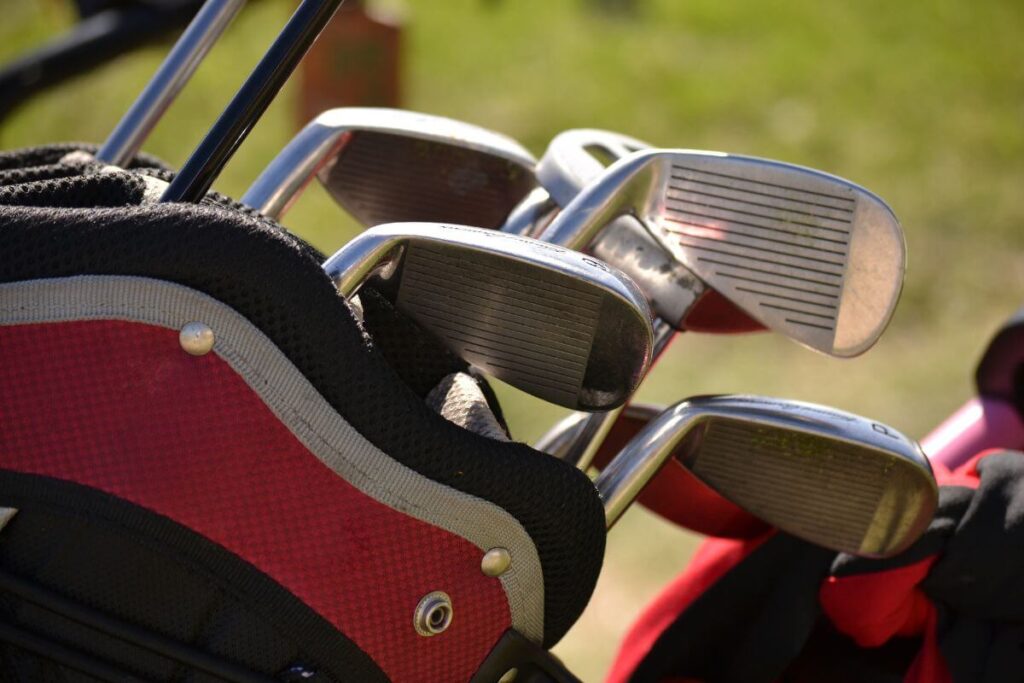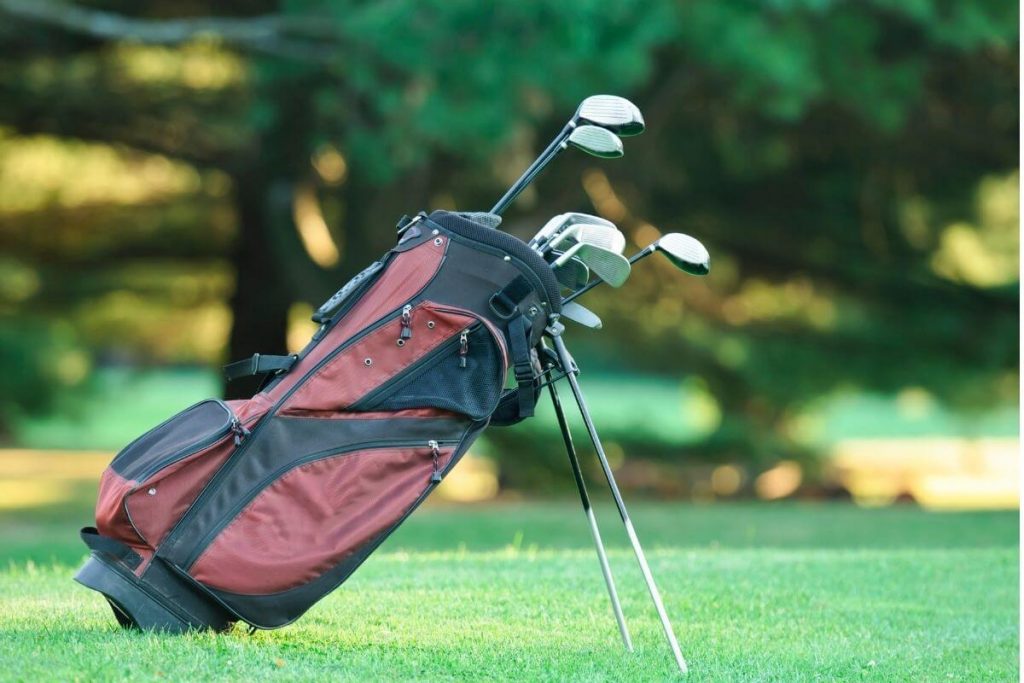Enormous advances in technology over recent years have left consumers spoiled for choice when it comes to club selection.
The market has never been more exciting or more confusing. The sheer variety of clubs available, the accompanying jargon, and the advanced construction materials used can sometimes make it difficult to make the right equipment-buying decisions.
Choosing the right golf equipment is important if you want to improve your game. The wrong clubs can make it difficult to hit the ball accurately. In this article, we’ll show you how to choose the right golf equipment for your game. This includes selecting the right driver, woods and hybrids, to choosing the right wedges and putters.
When choosing golf equipment, it’s important to consider your level of play. If you’re a beginner, it’s important to choose clubs that are forgiving. That means they have a wider sweet spot and will help you hit the ball straighter. Forgiving clubs will also have a lower center of gravity, which makes it easier to get the ball airborne.
With that said let’s jump in.
Table of Contents
How To Choose The Right Equipment For Golf?
Choosing Drivers
When purchasing a driver, consider the elements that influence a club’s playability. First, the size of the clubhead; big clubheads provide a larger hitting area than small ones.
The loft on the club is also critical. Powerful ball-strikers can get away with a loft of only seven degrees. But the height of your shots also dependson the center of gravity on a club.
Clubs with a low center of gravity help the ball become airborne, which suits the less-accomplished player. Other clubs have a higher center of gravity, which gives a more penetrating ball flight.
Most drivers are made of steel. But titanium, although more expensive, is also popular, since it is light. The clubhead can be bigger and thus more forgiving.
Make sure that the grip fits your hands
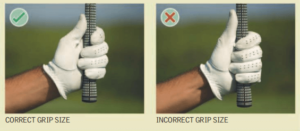
A club’s grip tends to be overlooked by many golfers, yet it is the only point of contact between you and the club.
Therefore, it makes sense that the grip should suit your hands. In addition to keeping grips in good condition— replacing them when they become shiny or smooth—you also need to make sure that they are the correct size.
Perform this simple test. Hold a club in your left hand. Ideally, your middle two fingers should lightly touch the fleshy pad at the base of your thumb.
If they do not touch at all, or the tips of your fingers dig into your palm, your grips need to be adjusted. This is a straightforward job that can be done by any club professional.
Finding the correct lie angle
The angle at which the bottom edge of the club sits on the ground is known as the lie angle. If this is too upright, the heel will make contact with the ground first at impact. Conversely, if the angle is too flat, the toe of the club will strike the ground first. To avoid these problems, check that the bottom edge of the club is level with the ground at address.
Then hit a few shots. If the lie angle is correct, the start of the divot-mark will be uniform in shape and depth and pointing straight at the target.
If this angle is either too flat or too upright, check your set-up. If this is as it should be, the club professional can adjust the lie angle.

Choosing Fairway Woods
You should consider the same factors when buying a fairway wood that you do when purchasing a driver. However, the clubhead should be smaller because on the fairway it is more difficult to strike the ball out of the sweet spot of a big clubhead.
Your main concern should be the club loft. A loft of between 15 and 18 degrees strikes a balance between distance and accuracy.
It is also a good idea to introduce a utility wood, a type of fairway wood, to your set. These versatile clubs are effective from a variety of lies.
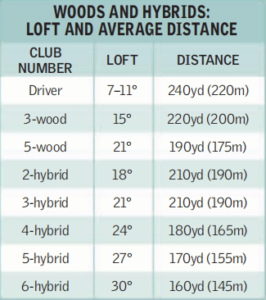
Choosing Hybrids
The hybrid or rescue club has a smaller clubhead than that of a fairway wood. The clubhead is like an oversized long-iron with a bulbous back edge, and it produces the ball flflight features of a long-iron without any of the hardships.
The hybrid is very versatile. It’s a superb club to use off the tee on tight par 4s—the generous loft and relatively short shaft optimize accuracy without much drain on distance.
The rounded, compact clubhead makes light work of clingy rough and the rounded design redistributes the clubhead mass.
This boosts the size of the sweet spot on the face and lowers its center of gravity, which make it more forgiving.
Compact and forgiving, the hybrid is suitablefor a wide range of shots. It is even used for chipping and around the greens.
Irons
As with drivers, different iron clubs used to be subtle variations of what was basically the same theme. Today, however, manufacturers are in a constant race with one another to come up with the latest innovation. This means there is a variety of clubhead designs.
However, the key issues when you come to buy are: how much forgiveness do you want, how important is it for you to shape the ball through the air, and do you like the look of the club? You then narrow your options, making the buying process that much easier.
When it comes to clubhead construction, there are two main types: blades and peripherally weighted irons.
Blades
These clubs, by far the most popular irons up until the late 1970s, have a forged clubhead and a plain shape. Although relatively unforgiving to off-center strikes, blades produce a purer feel at impact and offer greater scope for shaping the ball through the air.
Today, blades are still favored by traditionalists and some professionals and accomplished amateurs.
Providing the purest feel at impact, blades make it much easier to shape shots at will through the air.

Peripherally weighted irons
Also known as “cavity backs,” the peripherally weighted irons often have cast rather than forged clubheads and are designed to offer maximum forgiveness to off-center hits. This is because they have more weight at the extremities of the clubhead.
In addition to peripherally weighted cast clubs, there are now many “in-between” peripherally weighted irons available that offer some of the benefifits of bladed irons yet are still forgiving to off-center strikes. Some of these irons, especially those used by many of today’s professionals, are even designed to look very much like a blade.
Peripherally weighted irons are more forgiving to off-center strikes but do not make it so easy to shape shots.
Chosing Wedges
You should have at least three wedges within 46 and 62 degrees of loft for versatility in your short game. The degree of bounce you select depends on the kind of shots you wish to play.
For fairway shots, less bounce is desirable (no more than 5 degrees). From most types of sand, soft ground, and rough,however, you need more bounce (between 10 and 14 degrees). Steel is the standard metal for wedge clubheads.
Clubs with lots of bounce such as sand wedge work best in soft, powdery sand; clubs with less bounce are suited for coarser sand.
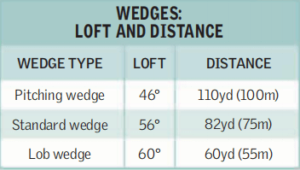
Choosing Putters
Since about 40 percent of the shots in an average round are putts, it is crucial to use a putter with which you feel confifident.
Putters can have standard-length or long handles, and there are three main types of putterhead— peripherally weighted, mallet-headed, and center-shafted.
Peripherally weighted putters are made using the same principle employed in peripherally weighted irons.
A mallet-headed putter has a semicircular head and offers the same benefifits as a peripherally weighted one. Center-shafted putters are less forgiving with off-center hits than a peripherally weighted club.
One of the three basic putter designs is the mallet-headed putter.
Putterface inserts
Manufacturers have responded to golfers’ quest for maximum feel on the greens by introducing the concept of face inserts in putters.
Some inserts are made from relatively soft rubber compounds, while others are built up from complex mixtures of metals. The idea behind these inserts is to promote a soft feel off the putterface to enhance control and give the ball a smooth roll.
Some professionals have fat grips fifitted to their putters. These reduce excessive wrist action during the stroke.
In these clubs, the weight is positioned across the clubface to minimize performance loss caused by off-center strikes.

